Things Powered by the Sun
The Sun’s Energy
The sun is the ultimate source of energy for the Earth. Life on Earth is fueled by light from the sun. Many things on the Earth are powered by the sun. Plants use the energy of sunlight to produce simple sugars and these sugars are the building blocks which allow the organism to grow. Animals indirectly use the sun’s energy by consuming the products of autotrophs. Some animals directly consume autotrophs while others consume heterotrophs. Many of the natural occurrences are due to the influence of the sun’s energy. Man uses some of such occurrences to facilitate their energy requirements.
Solar power, geothermal power, and wind power are some of the power sources that produced with the assistance of the sun’s energy. Fossil fuels are another power source that has been generated as a result of the sun’s energy. In this sense, most of the energy requirements are direct or indirect results of the influence of the sun. Before actually understanding all these energy mechanisms, it is important to know how the sun produces energy by itself.
Image: Wikipedia Commons, NASA/SDO, The Sun
How the Sun Produces Energy
The actual processes of the power generation of many things that are powered by the sun are easy to understand. However that’s not the case with the power generation of the sun itself.
The sun mainly consists of hydrogen and helium while less than 2% consists of heavier elements like oxygen, carbon, neon, iron, and others. (Helioseismology and Solar Abundances Report) The surface temperature of the sun is 5,800 K and the temperature of the core is close to 1.36 x 107 K. As a result of these extreme temperatures of the sun, a process called nuclear fusion occurs. (Garcia) In nuclear fusion, atomic nuclei fuse together to form a single heavier nucleus accompanied by the release of large quantities of energy. This is the process that occurs in a hydrogen bomb, which is thousands of times more powerful than a nuclear bomb that uses nuclear fission.
Image Gallery
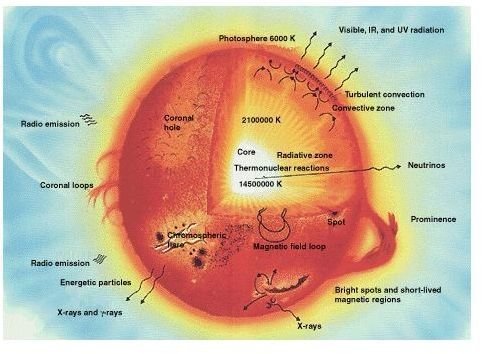
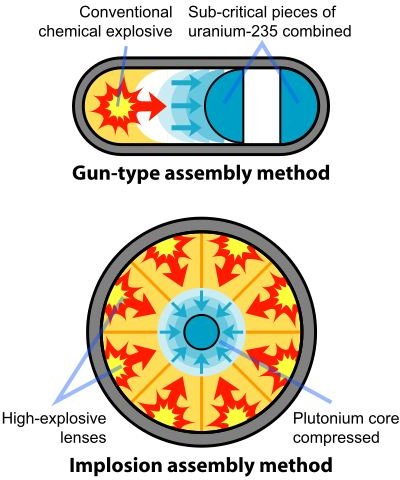
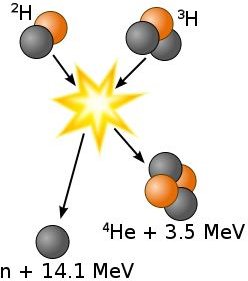
Image Credit:
- Wikipedia Commons, NASA/Goddard Space Flight Center, Cross Section of the Sun, Dr. Jim Lochner
- Wikipedia Commons, Fission Bomb Assembly Methods, Fastfission
- Wikipedia Commons, Deuterium-Tritium Fusion, Wykis
This nuclear fission reaction converts hydrogen into helium by releasing an enormous amount of energy. The sun releases its energy at the rate of 3.846×1026 W. As a comparison, the nuclear bomb that devastated Hiroshima city in Japan was exploded with an estimated energy of 54 to 75 x 1012 J (Hiroshima Peace Museum). The sun releases approximately five trillion times (5x1012) the energy in each second than the total energy released at Hiroshima nuclear bomb explosion. The energy released from the sun in this way reaches to the earth in the form of thermal radiation. People use it in various forms for their energy needs, and this is how the sun produces energy.
Wind Power
Wind power is a result of uneven heating of the Earth. The poles of the earth receive less heat energy from the sun than the equator. Also dry lands heats up quicker than the seas. These different heating is the reason for a global atmospheric convection system that causes vast variations of the climate and weather conditions on each part of the Earth. Wind energy that occurs in this manner is utilized to generate a useful form of energy by methods such as wind turbines, wind mills, sails, and wind pumps.
Wind energy is one of the most important things powered by the sun for many parts of the world where electricity facilities are not available. By the end of 2009, wind energy production was 340 TWh (340 x 1012 Wh), which is about 2% of worldwide electricity usage. (World Wide Wind Energy Report)
Image: Wikipedia Commons, Toro de Osborne, Jesus Martinez
Solar Power
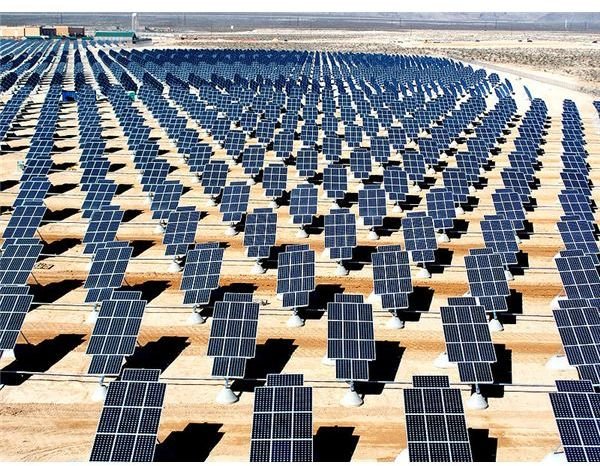
Solar power is another power generation method that uses the sun’s radiant light and heat. Today solar powered devices such as solar powered lights and even solar powered cars are becoming more popular due to solar power’s ease of use. Heat engines and photovoltaics are the methods that used to generate electrical power from solar power. However, only a small fraction of solar energy is actually used for electrical power generation when we consider the amount of solar energy that the Earth receives each day. This is 174 x 1015 W of incoming solar radiation (Smil) and only about 30% is reflected back to space. Earth’s atmosphere absorbs about 3.85 x 1024 per year. Earth absorbs more energy in an hour than the total world energy usage in 2002.
Passive solar building design is a new concept used to create solar powered architecture. Modern designs include solar lighting, heating, and ventilation systems in the same design. Another area where energy from the sun is used is in agriculture and horticulture. Techniques such as timed planting cycles, staggered heights between rows, mixing of plants, etc. are used to improve crop yields. There are number of solar powered devices available today. Solar powered lights, cars, chargers, and other small electronic instruments are some of them.
Image: Wikipedia Commons, U.S. Air Force photo, Giant Photovoltaic Array, Airman 1st Class Nadine Y. Barclay
Geothermal energy
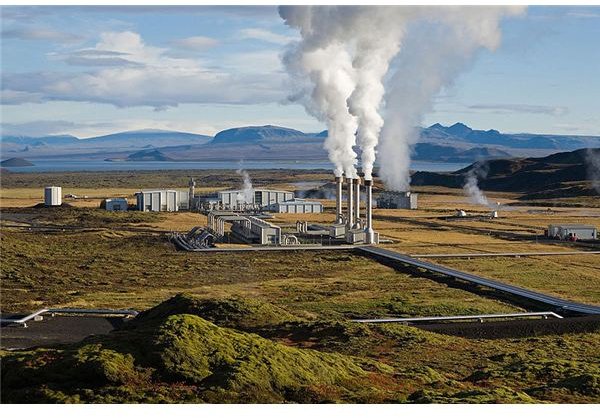
Geothermal energy is another new method for the production of electricity. Actually geothermal energy means the thermal energy stored in the Earth. The Earth’s geothermal energy is originated from the formation of the planet, volcanic activity, decay of minerals, and from solar energy absorbed at the surface. Therefore geothermal energy is also a power source that indirectly originates from the Sun.
Although geothermal power is a reliable, environmentally friendly, and cost effective way of producing energy, it has been limited to special land requirements such as near locations to tectonic plate boundaries. However recent developments have remarkably expanded the availability of potential areas for the power generation. Today about 10,715 MW of geothermal power is produced in 24 countries. (Geothermal Energy Association)
Image: Wikipedia Commons, Nesjavellir Power Plant, Gretar Ívarsson
Fossil Fuels

It might be confusing to say that fossil fuels are also solar powered. However that’s the truth. Fossil fuels are formed by anaerobic decomposition of dead animals and plants. Plants capture the sun’s energy, and this energy is released from fossil fuels when we burn them. That’s why natural gases, coal, petroleum, etc. all are solar powered.
Actually as humans we all possess a massive debt to the sun for its enormous and continuous energy supply because almost all the energy that exists on Earth is originated by the direct or indirect effects of the sun’s activity. However, only a very small fraction of the sun’s energy is used for useful purposes. Thanks to the immense efforts of scientists and researchers, already highly advanced solar powered devices and geothermal power solutions are available. Still there are vast potential energy supplies that hardly touched by humankind. But, one thing is sure. One day we all will be able to enjoy more efficient and environment friendly energy supplies at a remarkably low cost.
Image: Wikipedia Commons - Gulf Offshore Platform, Chad Teer
References
- Basu, S.; Antia, H. M. (2008). “Helioseismology and Solar Abundances”.
- García, R.; et al. (2007). “Tracking solar gravity modes: the dynamics of the solar core”
- NASA/NSSDC, Sun Fact sheet
- Smil, Vaclav: General Energetics: Energy in the Biosphere and Civilization, Wiley, 1999.
- Hiroshima Peace Memorial Museum
- World Wind Energy Association: Worldwide Wind Energy Report 2009 (PDF)
- Geothermal Energy Association. Geothermal Energy: International Market Update May 2010
This post is part of the series: Things Powered by the Sun
The Sun is an immense source of energy for the beings on the Earth. Most of the earth’s energy sources are powered by the Sun. Not only solar power and geothermal power, there are so many other energy sources are unleashed due to the power of the Sun.
